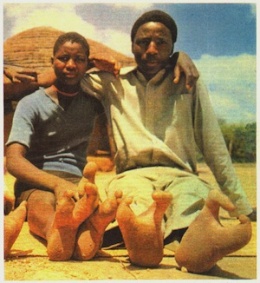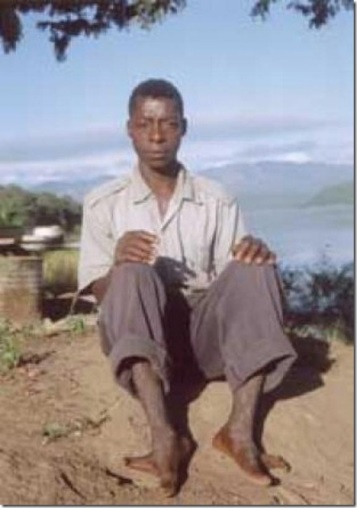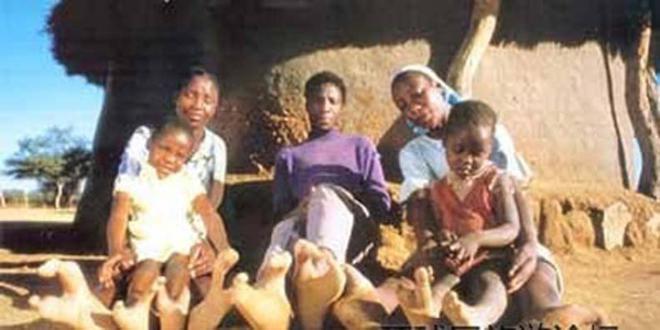You’ve probably never heard of the vaDoma people, but they’re a unique and fascinating tribe that lives in Zimbabwe.
What makes them so unique? Well, for starters, they’re the only tribe in Africa who have two toes on each foot! But that’s not all. The vaDoma people are also known for their rich history and strange culture passed down for centuries, which makes them stand out from the crowd.
Become an insider. Subscribe to our newsletter for more top trending stories like this!
Keep reading if you’re curious to learn more about the vaDoma people. In this article, we’ll take a closer look at this fascinating two-toed tribe in Africa and their unique way of life.
Who Are the vaDoma People?

The Bantwana tribe, also known as the vaDoma people, are residents of Northern Zimbabwe’s Kanyemba region, around the basins of Mwazamutanda River, a tributary of the Zambezi River Valley. They communicate in Dema, which is easily distinguished because it is very similar to another widely spoken language in the area.
The vaDoma tribe is well-known for its two-toed feet. And if you’re wondering why, the answer is simple: they evolved that way. The ostrich-foot syndrome, commonly called two-toed feet (scientifically referred to as Ectrodactyly), is a genetic defect in which a person’s middle three toes are missing due to a congenital disability, and their remaining two outermost toes turned inward.
The ostrich-foot syndrome gives the people of vaDoma, the nickname “two-toed tribe in Africa.”
Culture of the vaDoma People: The Two-Toed Tribe in Africa

One of the most distinctive customs of the vaDoma people is their two-toed feet-a genetic trait passed down from generation to generation. Hundreds of years ago, the vaDoma people lived as hunter-gatherers, similar to the San people in the Tsholotsho Area in Zimbabwe. Although the two-toed tribe of Africa consider themselves hunter-gatherers, modern definitions suggest otherwise. The residents of vaDoma are criticized for living as poachers rather than hunters because they lack hunting licenses.
Historically, the vaDoma people chiefly reside in the mountains and rely on a nomadic lifestyle of hunting, fishing, trapping, honey hunting, and gathering wild fruits and roots. They are currently Zimbabwe’s only non-agricultural society, and due to their resistance, they have limited access to fertile land. Stereotypes refer to them as “stone age cave dwellers.”
By nature, VaDoma people are pretty shy; when they talk, they avoid looking you directly in the eyes and instead fix their gaze on the ground. Game rangers frequently harass them, making them flee from people. They have isolated themselves from the rest of Zimbabwe and now live a semi-foraging lifestyle, living in wooden houses with thatched roofs to protect themselves from the elements and predators. They maintain strict and sanctimonious relationships amongst themselves because they do not marry outsiders (other tribes with five toes).
Become an insider. Subscribe to our newsletter for more top trending stories like this!
The people of vaDoma are a close-knit community. They take great pride in their heritage and are very keen on maintaining their way of life for life. Several modern facilities, like a primary & secondary school, including a clinic, were built, but they abandoned these facilities and stuck to their traditions. They also detest textile fabrics; kids as young as ten don’t dress themselves.
Myths about the Two-toed Tribe in Africa

Along the line, the origin of the two-toed tribe in Africa appears to no longer exist. Hence, different community elders and others hold some beliefs about the source of the vaDoma people.
According to one of these myths, their ancestors came out of a baobab tree, walked upright, and immediately started their daily routine of hunting and gathering fruits of the land. The community’s elders also hold that their ancestors were similar to birds that descended from the stars. They fused their DNA with Earth women, creating the vaDoma people.
In the Zambezi region, the name vaDoma refers to semi-mythical people who are magical, capricious, difficult to find, and live among the trees. A few persistent rumors claim that the vaDoma people can perform magic and vanish into the forest. How fascinating?!
There’s more to know about the Two-Toed tribe in Africa than we can cover in this article. So, if you’re ever in Zimbabwe, pay a visit to the vaDoma people and learn more about their unique way of life. You won’t regret it!
Read Also: The Not-So-Known History and Traditions of Mardi Gras
Become an insider. Subscribe to our newsletter for more top trending stories like this!






Excellent post. I certainly appreciate this website. Keep writing!